|
|
Astronomical optics for the professional and amateur market |
| |
|
The most common low expansion glasses used are "Suprax" from Schott in Germany, and Pyrex from Corning in the USA.
|
|
|
|
Newtonian Telescope Optics |
| Most of the optical elements are made for Newtonian telescopes. This type is the most commonly used of all astronomical telescopes.
This is due
to the relative ease of construction, portability, insensitivity to optical alignment, and low purchase cost compared to other telescopes with similar apertures. |
| |
| This telescope design requires a primary mirror placed at the bottom of the telescope tube, plus a relatively small elliptically shaped flat mirror which is placed near the top of the tube to deflect the image out to the side of the telescope tube. The Dobsonian design is a Newtonian telescope that is very popular and often recommended as an amateurs first telescope. Most 300-400mm designs easily fit in the boot of a small car, and we have
seen carefully designed 600mm units fit in as well. |
|
|
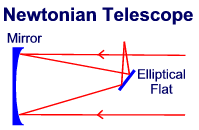 |
|
|
|
Folded Newtonian Telescope Optics |
| If you want a Newtonian with high magnification - then you need a long focal length. However the eyepiece is always near the top of the telescope tube in a Newtonian Telescope and if you are operating at high elevations, you will need to stand on something to get to the eyepiece. |
| |
| Depending on what you arrange to stand on, and remembering you are going to be doing this on a dark night - there has got to be a possibility of falling off and injuring yourself. If this could be a worry for you there is an alternative that will keep your feet firmly on the ground, and that is the "Folded Newtonian" |
|
|
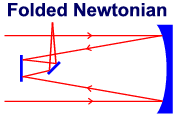 |
|
|
This introduces a circular optical flat at the top of the telescope tube to reflect the light back down to the elliptical flat at a convenient height.
This version of the Newtonian works well with larger primary mirrors slower than F/4 and focal lengths in the 8-16' range. Note that as well as
lowering the height of the eyepiece, the total length of the telescope tube is reduced which may be significant if you are building a dome to enclose it. A disadvantage is the extra obscuration caused by the circular flat, - but this may be a sensible price to pay for ease of use and safety. The extra Optical Flat is not as expensive as a secondary mirror for a Cassegrain telescope. |
|
|
|
Cassegrain Telescope Optics |
| This Telescope gives a longer effective focal length and higher magnification to the Newtonian for a given Telescope length or eye piece size. This is made possible by the light being folded back down the telescope tube. This makes for a more compact telescope. This design has
two curved reflecting mirrors. |
| |
| The concave primary mirror has a hole at its centre, and is placed at the bottom of the telescope tube. A smaller convex secondary mirror is placed near the top of the telescope.The secondary mirror reflects the light from the primary mirror back down the tube through the hole in
the primary, to the focus point behind. |
|
|
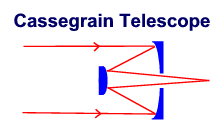 |
|
|
There are various types of Cassegrain systems characterised by the curves used on the primary and secondary mirrors. The original type
is now simply known as the "Classical Cassegrain". It used a parabolic primary mirror with a hyperbolic secondary mirror. It offers no optical advantage
over the later types except that it can be turned into a Newtonian by replacing the secondary mirror with an elliptical flat. |
|
|
There is very little demand for this type today, but we are happy to make you one if you want one!Later types of Cassegrain are named after their inventors/engineers. The two main
types we supply are the Dall-Kirkham and the Ritchey-Chretien.The Dall-Kirkham has a spherical secondary with
an under-corrected paraboloid primary which makes it slightly easier to manufacture. It is quite suitable for direct viewing with small fields of view, - but it does exhibit significant coma and wider fields are impractical.If you want a telescope for direct viewing
with a really long focal length but still keep a relatively short tube, then a Dall Kirkham of around F/20-25 offers a practical solution with a low obstruction ratio. |
|
|
The Ritchey-Chretien has overcorrected paraboloid (hyperbolic), primary and secondary and has the major advantage of being coma free.
This type constitutes most of our Cassegrain production. Since it is coma free, it has a wide field and can be used equally well for direct viewing, 35mm or even medium format photography. |
|
|
|
Gregorian Telescope Optics |
Although we do not build many Gregorian telescopes, this is shown for completeness. Both the Newtonian and the Cassegrain have the
drawback that they invert the image and are not very useful for terrestrial viewing without some external arrangement to re-invert the image.
The Gregorian produces an erect image directly so
is better suited to terrestrial viewing. |
| |
| In construction it is very similar to the Cassegrain, except that the secondary mirror is concave and is placed beyond the primary's focal point.
This has the disadvantage of making the tube length a little longer than a pure Cassegrain, but it this feature that causes a second inversion of
the image, making the telescope suitable for terrestrial viewing. If you need a short powerful telescope for terrestrial use then it makes very good sense to consider the Gregorian as a possible option. |
|
|
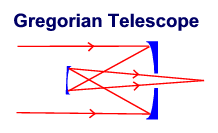 |
This is the area in which firms like Meade and Celestron do a lot of business. It is said in the Schmidt Camera section that the corrector
plate must be at the centre of curvature for optimum correction - it can be brought closer, but coma is introduced.
However if Cassegrain telescope optics are substituted for the spherical mirror, then the mirror surfaces can be specially figured to counteract the coma and most of the other aberrations.
This arrangement is known as a Schmidt Cassegrain telescope. |
| |
Note that in spite of having a corrector, the telescope will not have the wide field of a Schmidt Camera. The field
is comparable to that of any other Cassegrain telescope. The presence of the corrector does theoretically allow extra degrees of freedom to cancel out aberrations compared with a Ritchey Chretien, which has only the two surfaces. However, the corrector plate introduces some new aberrations of its own. |
|
|
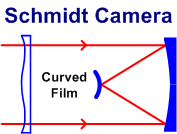 |
This is a derivative of the Cassegrain and is a very clever and practical telescope design that is in our opinion
very under rated and under used. The Folded Newtonian was introduced to lower the height of the eyepiece.
With a Cassegrain, the converse can be a problem with the eyepiece sited too low for comfortable viewing. |
| |
| The focal point of a Cassegrain is behind the primary mirror and if you intend viewing at high elevations, then the tube of the telescope would have to be supported high off the ground. It is of course possible to fit a 90 Degree bend on the focuser of a standard Cassegrain for use at
high elevations, but if the telescope is above 12" Diameter, you will still need a strong, tall and relatively expensive mounting. |
| |
So if you are considering a Cassegrain of 12-24" or above, then why not consider having the 90 degree bend
built into the design at the start? This is the design credited to James Nasmyth. It is a Cassegrain optical system with an extra elliptical flat from a Newtonian bending the light out the side of the tube. The extra cost of the elliptical flat is not significant when the cost of the other two mirrors is considered. |
|
|
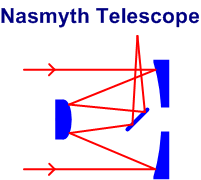 |
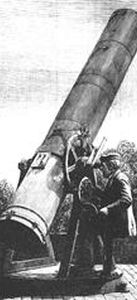 |
|
| The Nasmyth opens the possibility of using a much simpler and lower mount, as illustrated by the very basic design on the right which shows the focuser
carried on the top of the tube. |
| |
The primary mirror does not need a central hole for optical purposes, but it is often there to provide a mounting point for the elliptical flat. If the elliptical flat is towards the primary end of the tube, there are no extra optical obstructions and as an extra bonus, the baffling needed in standard Cassegrains is not required. Stray light has a lot more difficulty in reaching the focal
surface with this design. |
| |
| Very large professional telescopes often have a "Nasmyth focus" deliberately aligned on a hollow axis of the telescope mounting so that the eyepiece and viewing position are always maintained in the same position and at the same height. This is illustrated by the original 20" Telescope built by James Nasmyth in 1845 |
| |
| Some dictionaries suggest the feature of the hollow axis and fixed viewing position marks the "true" Nasmyth Telescope but there is no generally accepted
name for the simpler version. |
| |
Note that a modern Nasmyth Telescope would have the same tube length as any modern Cassegrain or Schmidt Cassegrain.
It would certainly not have the
long tube of the original 1845 version illustrated on the right, which looks more like it belongs to the artillery than an astronomer! |
|
|
|
| |